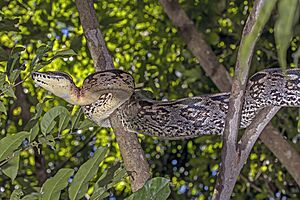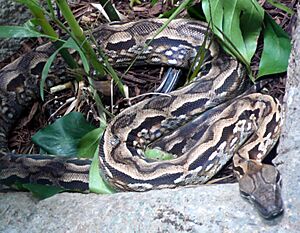Acrantophis madagascariensis facts for kids
Quick facts for kids Acrantophis madagascariensis |
|
|---|---|
 |
|
| in Lokobe Strict Reserve, Madagascar | |
| Conservation status | |
| Scientific classification | |
| Genus: |
Acrantophis
|
| Species: |
madagascariensis
|
| Synonyms | |
|
|

The Madagascar ground boa (scientific name: Acrantophis madagascariensis) is a type of large snake. It belongs to the boa family. This snake lives only on the island of Madagascar. It is also called the Malagasy ground boa.
Contents
Madagascar Ground Boa Facts
The Madagascar ground boa is part of the Boidae snake family. This family includes many large, non-venomous snakes. There are no different types (subspecies) of this snake known today.
Size and Appearance
Female Madagascar ground boas can grow up to 10 feet (3.0 metres) long. Males are usually a bit smaller. The average size for these snakes is about 8 feet (2.4 m) long. This makes it the biggest snake found on the island of Madagascar.
The snake's body color is usually a mix of pale reddish-brown and gray. It has a pattern of diamond shapes on its back. These shapes are outlined in black or brown. Sometimes, this pattern looks like a zigzag. The sides of the snake have black oval spots. These spots often have reddish patches inside them. They might also have white borders or centers.
How They Hunt
Like other boas, the Madagascar ground boa catches its food by squeezing it. This method is called constriction. They wrap their strong bodies around their prey. This stops the prey from breathing.
Where They Live
The Madagascar ground boa is found only in Madagascar. It lives in the central, northern, and western parts of the island.
These snakes usually live in open woodlands. They prefer places like the Madagascar dry deciduous forests. These forests have trees that lose their leaves in the dry season.
Conservation Status
The Madagascar ground boa is currently listed as "Least Concern" by the IUCN. This means it is not in immediate danger of extinction. This classification was given in 2011. Before that, it was listed as "Vulnerable." This older status meant its population had dropped by at least 20%. This was due to habitat loss or being caught too much.
This snake is also listed under CITES Appendix I. This is an international agreement. It means that selling these snakes for money across borders is not allowed. Any non-commercial trade is strictly controlled.
Dangers to the Boa
Even though it's "Least Concern," the Madagascar ground boa still faces some threats. These include:
- Deforestation: Forests where they live are being cut down.
- Human Population Growth: More people means more land is used.
- Development: Land is cleared for farms and factories.
- Illegal Pet Trade: Some people try to catch these snakes to sell them illegally as pets.
For now, these threats only affect the snakes in certain areas. The species as a whole is not in danger yet.
Boa Behavior
Madagascar ground boas like to hide in safe places. They use burrows made by other animals. They also hide under fallen trees or piles of debris. These spots offer good protection.
Winter Rest
During the cool, dry winter months, usually from May to July, these snakes go into a special resting state. This is called Brumation. It's similar to hibernation for mammals. During brumation, their bodies slow down.
What They Eat
The diet of the Madagascar ground boa includes small animals. They eat both mammals and birds. Some of their favorite foods are:
Reproduction
Madagascar ground boas mate after they come out of their winter rest (brumation). A female snake might mate with more than one male.
Giving Birth
These snakes are ovoviviparous. This means the mother carries the eggs inside her body. The eggs hatch inside her. Then, she gives birth to live young. Females usually have 2 to 4 large baby snakes. The babies are born after a long pregnancy. This period lasts about 4 to 6 months.
Newborn boas are quite big, measuring 19–24 inches (48–61 centimetres) long. They are ready to hunt and eat small rodents and birds right away.



